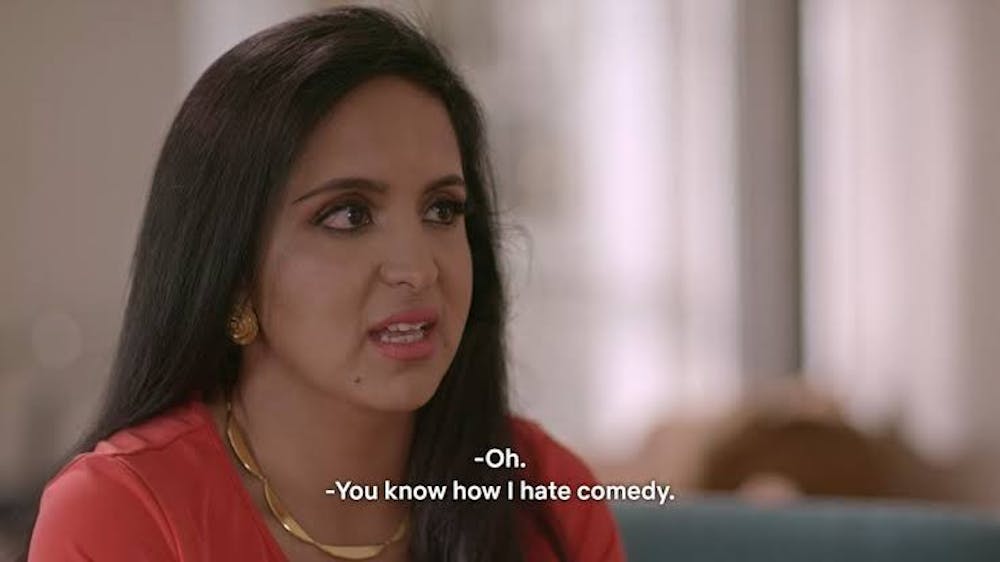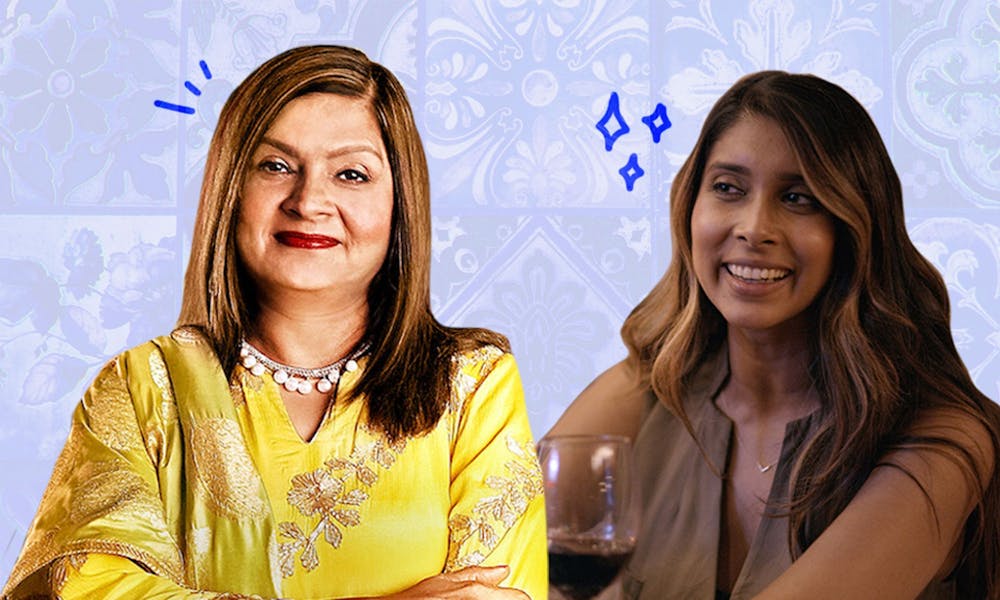The appeal of the dating show is the unspoken desire for a neatly–tied ending, shared between both the viewer and participant; it's the guarantee that these carefully selected personalities you watch throughout the season are capable of finding love (and maybe you can too). In a room of gorgeously eligible singles, each reduced to a handful of lines per episode, it is both indulgent and reassuring to entertain the notion that the character you identify with will come out holding the final rose. As we watch strangers profess their family histories and prioritized qualities in a life partner, we are granted breathing room to feel less self–conscious about our own. We normalize the notion that there is someone out there curated to match our idiosyncrasies perfectly.
This is why it comes to no surprise that Indian Matchmaking has become one of Netflix’s most–streamed programs following its debut. The show follows professional matchmaker Sima Taparia (addressed as Sima Auntie) as she outlines her process for how she uses blurbs of information about her clients as blueprints to build successful, sustainable relationships. She travels between Mumbai and America to present biodatas to her candidates, sheets of paper which contain a low–quality image of the potential partner alongside their interests, hobbies, career, and education.
Indian Matchmaking works to desensitize the clouded confusion surrounding arranged marriages through the lens of Western media. It presents the practice in a calculated, logical manner while still containing the electric nerves of a first date, in a way that makes you ask yourself why you haven’t been analyzed yet to find 'the one.' But while the process regarding matchmaking becomes more clear, there is an entire political and cultural context to the tradition which remains hidden.
One piece of this context is the rampant colorism which enables arranged marriages to act as an instrument for racial superiority. In a country where marriage is described as an industry, and the act of marrying is a business procedure, India’s discrimination against its darker–skinned population traces back to its history of British colonization and adopted racism. Viewers of the show watch as Sima Auntie casually explains how fairness of the skin is a prized quality for clients, with no discussion about the undeniable prejudice against those who are deeper complected, also seen in the fact that nearly half of skincare products in India are marketed to lighten one’s skin color.

As an Indian American, Sima Auntie’s normalization of the topic is not surprising, given that I grew up learning to avoid the California sun, or that I witnessed Priyanka Chopra’s endorsement of a whitening face lotion. But I am not the target audience member for Indian Matchmaking. To be quite honest, I'm not sure who is. While the show does not feel the need to elaborate on the accepted terms and conditions which accompany the matchmaking process (let alone offer an education on the need for change), it also does not shy away from shaping the audience’s perception of Sima’s clients and their families to mimic those in Indian culture as well.
The first character on the show, Aparna, introduces herself as a lawyer who spent the majority of her early years building her professional career and traveling for her enjoyment. Immediately, her driven qualities, financial independence, and secure understanding of her identity are weaponized against her. She is portrayed to be difficult to get along with, speaking opinions to her dates which the show portrays as outlandish in simple conversation.

I recognized the show’s use of her characterization immediately as a demonstration of the crazy girl trope: the idea that a woman who is not the right concoction of submissive–yet–interesting must be fundamentally flawed. It’s a manifestation of internalized misogyny which many women are forced to witness, particularly South Asian women, and one that I experienced early on at Penn within that community.
For example, months after a one–hour Saxby's date, where a friend–of–a–friend and I shared a singular conversation, I learned that I acquired a crazy–girl reputation thanks to his word–of–mouth. I felt ashamed that this was how I was perceived by men who understand the value of our culture, one that Indian Americans are expected to uphold and pass down to our children. And for what this was a consequence of, I will never understand—an explanation of what I enjoy doing for fun, maybe?
The truth is, it does not matter how this trope is perpetuated or where it comes from, because Indian Matchmaking hardly even recognizes its existence as much as it does utilize it for entertainment. Aparna speaks her mind, she knows exactly what she is looking for and talking about, and therefore she is not the client deserving of a happy ending—because she is the most important part of her life, an aspect she must change. Even when she finally meets a fellow lawyer who she admits to having chemistry with, the show ends up shuffling him around to Nadia, a bubbly bachelorette with a more easygoing, spiritual demeanor.
The show's subtle acts of misogyny are stretched across nearly every scene, every match. While Aparna is urged to dilute her forward personality to find one suitable match, other clients such as the trendy Pradhyuman admit to reading dozens of biodatas of women in hopes of finding one capable of attracting him. It is not until he meets with a literal model that he contemplates entering the dating sphere. Similarly, the show builds up anticipation over a couple of episodes of whether or not Akshay will work together with his mother’s incessant demands for her future daughter–in–law. When the audience finally watches his family meet the girl he selected, the two barely make conversation and she is reduced to a plot device with a set of alluring eyes for Akshay and his mother’s strained relationship.
These disparities among the roles of men and women in the show's portrayal of the matchmaking process and in the South Asian communities across the world are arguably consequences of the misogyny which plague arranged marriages in India still to this day, such as the upkeep of the dowry system following its ban in 1961. But neither Sima Auntie nor the show's other characters make a mention of this disparity, the progress our culture has achieved to overcome it, or the progress there is still yet to be made (and could have been contributed to, had the show taken the time to educate viewers on the misogynistic marriage industry). Not to mention, the show contains only heterosexual pairings and identities and only contributes to the erasure of the LBGTQ+ community in India where conversion therapy persists.
Indian Matchmaking promises to find sustainable connections yet deflates before the end of the season, instead merely displaying a narrow definition of the arranged marriage plot with a set of conditions already in place. It is difficult to dismiss the program as merely problematic for it does not even afford viewers the chance to understand how it might be. Unless they are already familiar with the entire culture it is immersed in, a culture which the show’s sole agenda is to modernize, the context remains muddied. While it is built on promoting the matchmaking process, its lack of self awareness ultimately leads to its own demise, especially in an age where entertainment should be tied with social progress.

